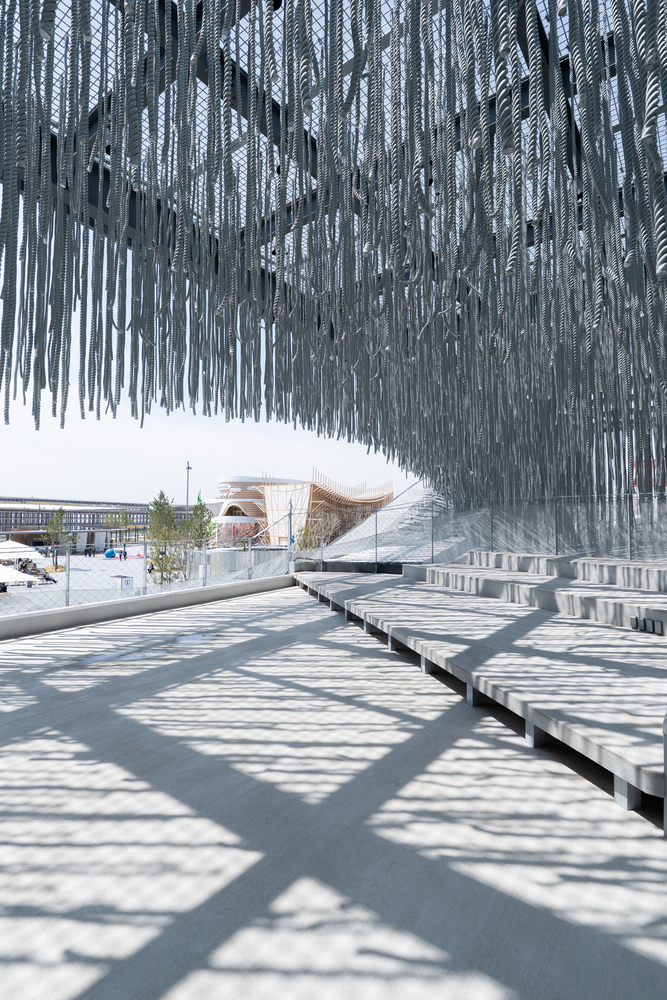"건축은 자연과 대립하는 것이 아니라, 자연과 대화하는 것이다." - 켄고 쿠마

바다의 숨결을 건축으로 빚어내다. Kengo Kuma & Associates-Expo Osaka 2025 Portugal Pavilion
켄고 쿠마의 2025 오사카 엑스포 포르투갈 파빌리온
포르투갈과 일본은 모두 대양의 품에 안겨 역사를 써 내려온 해양 국가입니다. 대항해 시대, 포르투갈 탐험가들은 미지의 바다를 가로지르며 서양 문명을 다네가시마에 전하고 일본이 서방 세계와 소통하는 관문을 열었습니다.
이러한 두 나라의 해양적 연결고리를 건축 언어로 표현하고자, 켄고 쿠마는 세토 내해의 섬에 자리한 엑스포 현장에서 방문객들이 바다의 존재를 온몸으로 체험할 수 있는 파빌리온을 구상했습니다. 산은 그 형태가 뚜렷하지만, 바다는 정해진 형태가 없어 건축적으로 표현하기란 쉽지 않은 도전이었습니다. 그러나 켄고 쿠마는 이 도전이야말로 가장 가치 있는 건축적 여정이라 여겼습니다.
이 프로젝트에서 켄고 쿠마는 형태보다는 감각에 집중하여, 바다의 본질을 물리적으로 경험할 수 있는 '장소성'을 창조하고자 했습니다. 대항해 시대 항해의 필수 도구였던 로프를 건축 소재로 재해석하여 독특한 공간 경험을 구현했습니다. 두께가 다양한 수천 가닥의 수직 로프들이 건물 외피를 이루고, 그 사이로 바람이 지나가면 천천히 흔들리거나 미세하게 진동합니다. 이 로프 사이로 스며들고 반사되는 빛은 끊임없이 변화하는 그림자 패턴을 바닥과 벽면에 그려냅니다. 이 모든 요소가 어우러져 파도의 움직임과 물결의 진동으로 이루어진 바다의 본질을 공간적으로 재현합니다.
일본 건축에서 흔히 볼 수 있는 '간(間)' 개념처럼, 이 파빌리온은 비어있는 공간과 그 사이의 관계성을 중시합니다. 로프 사이의 빈 공간은 단순한 '없음'이 아니라, 빛과 바람, 시선이 오가는 활발한 교류의 장이 됩니다. 이는 한국 전통 건축의 '처마' 아래 그늘이 만들어내는 반투명한 경계와도 맥을 같이합니다.
전통적인 건축은 보통 무거운 질량감과 고정된 형태로 인식되지만, 켄고 쿠마의 포르투갈 파빌리온은 끊임없이 움직이고 진동하는 전례 없는 건축 경험을 선사합니다. 이는 19세기 이후 세계 건축을 지배해온 무거운 콘크리트와 철골 구조물의 견고함에 대한 반성적 접근이자, 생명체처럼 자유롭고 경쾌한 새로운 건축 패러다임을 제시합니다.
이 파빌리온에서 느껴지는 가벼움과 투명성은 서울의 현대건축문화센터나 국립현대미술관의 반투명 유리 파사드가 만들어내는 빛과 그림자의 놀이와도 맥을 같이합니다. 또한 최근 한국 건축에서도 주목받고 있는 '경계의 모호함'과 '물성의 재해석'이라는 동시대적 건축 담론과도 연결됩니다.
포르투갈과 일본, 두 해양 국가의 역사적 연결성을 현대적 건축 언어로 재해석함으로써, 켄고 쿠마는 국가와 문화의 경계를 넘어 더 자유롭고 인간적인 새로운 건축의 지평을 열고 있습니다. 이 파빌리온은 단순한 전시 공간이 아닌, 바다처럼 끊임없이 변화하는 살아있는 건축의 가능성을 보여주는 혁신적 시도로서 2025 오사카 엑스포의 주목할 만한 랜드마크가 될 것입니다.
Write by Claude & 5osa









Portugal, like Japan, is a country of the sea, with a deep connection to the ocean. During the Age of Discovery, Portuguese explorers sailed the world's oceans, bringing Western civilization to Tanegashima and opening Japan to the West.
We aimed to create a pavilion that reflects this connection, where visitors could feel the maritime presence on the Expo site, which sits on an island of the Seto Inland Sea. Unlike mountains, the sea has no form, so it is not easy to express it as architecture, but it was a goal worth tackling. We came up with the idea of creating an actual place – not a form – where one could experience the nature of the sea as a physical sensation. We used boat lines that were one of the main tools for sailing ships during the Age of Discovery. The wind blows through the myriad of lines that vary in thickness, causing them to sway slowly or vibrate minutely. Light filters through and reflects off the lines, creating a shifting pattern. Together, these elements evoke the essence of the sea – an ever-changing space shaped by waves and vibrations.
Architecture is perceived as a heavy, solid volume that is firmly fixed in site, but this Portugal Pavilion is an unprecedented kind of architecture that continues to move and vibrate. It is an architecture that is as free and light as a living creature, which replaces the lumps made of heavy concrete and steel structures that have conquered the world since the 19th century. By bridging Portugal and Japan, the two marine countries, we wanted to create a new, free, and humane architecture.
from archdaily